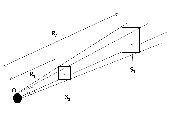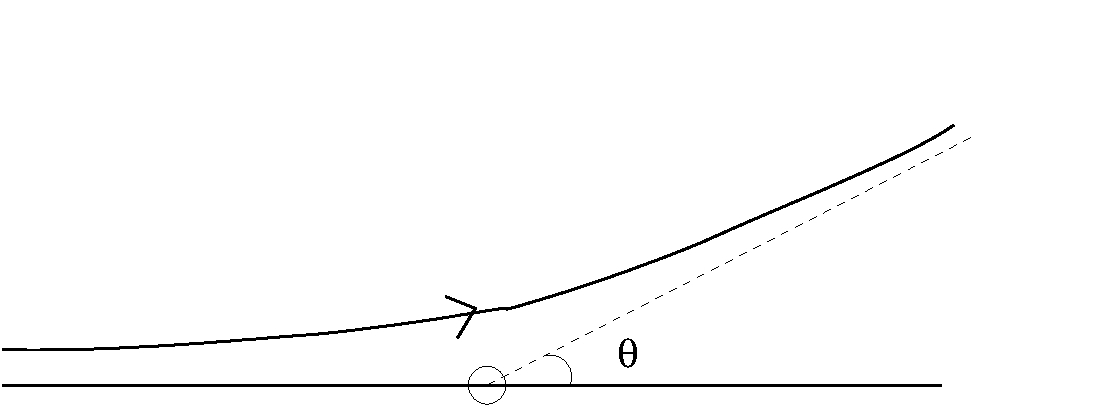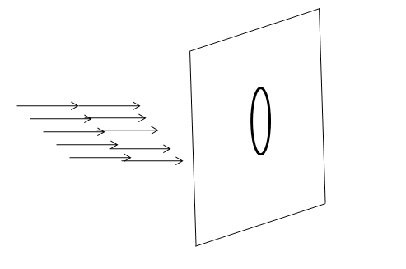Category:
We define solid angle, flux and the scattering angle and flux and cross section are defined.
Solid angle of a detector
Consider two detectors placed at distances $R_1$ and $R_2$ but having (subtending) the same solid angle at the scattering center $O$, see \Figref{Scattering1}. Since the particles are moving radially outwards and are moving like free particles, they do not accelerate or 'crowd' in the region between the surfaces $S_1$ and $S_2$. As no particles are absorbed or created, the number of particles crossing $S_1$ per second will be equal to the number of particles crossing $S_2$ per second. Note that the two surface $S_1$ and $S_2$ correspond to the same solid angle \(d\Omega=\sin\theta \, d\theta \, d\phi\). As area of a surface at a distance $R$ is $d\Omega\times R^2$ will increases as $R^2$ with distance, the intensity, defined as %
\[ \boxed{\text{intensity=no of particles detected per sec per unit area}},\]
will fall like $\frac{1}{R^2}$ with distance $R$.

Scattering Angle
Experimentally, the scattering angle is the angle between the incident and the scattered beams.
Knowing the potential $V(r)$, one can find the orbit and hence the position $\vec{r}\equiv\vec{r}(t)$ as a function of time is known, For large times, $t\longrightarrow \pm\infty$, $\vec{r}(t)$ varies linearly with time $t$, if the effect of potential in distant past and distant future can be neglected. The particles travel radially outwards in a straight line. We draw asymptotes to the particle trajectory at \(t=-\infty\) and at \(t=+\infty\). Theoretically, the scattering angle is defined to be the angle between these asymptotes, see figure below.

Flux
The flux of a beam is defined as number of particles in the incident beam crossing a unit area.(held perpendicular to the beam) per second.

Cross Section
If the flux of the incident beam is increased the number of particles scattered will increase proportionately in every direction.
| Total number of particles scattered out of the beam is proportional to incident flux |
| \(\therefore\) Total number of particles scattered out of the beam = $\sigma_t\times \text{flux}$ |
The constant of proportionality $\sigma_t$ is called the
Total cross section. Thus
\begin{equation}
\sigma_t\stackrel{\rm def}{\equiv} \frac{\text{Total no. of particles
removed from the beam per sec.}}{\text{Flux of the incident
beam.}}
\end{equation}
Similarly, we consider particles scattering in a given direction ($\theta,\phi$) into a solid angle $d\Omega$. Then the number of particles scattered into the solid angle $d\Omega$ will be proportional to the solid angle and to the incident flux. Thus we write
\begin{eqnarray}\text{No of particles}\hspace{-4mm}&&\hspace{-4mm}\text{removed from the beam and scattered}\\ && \hspace{-4mm}\text{ into the solid angle angle } d\Omega \text{ per sec}\\
&=&\sigma(\theta,\phi)\times \text{Flux} \times d\Omega
\end{eqnarray}
Therefore \(\sigma({\theta,\phi})d\Omega\) equals
\begin{eqnarray}
\frac{\text{No. of particles scattered per sec
into solid angle } d\Omega \text{ in }(\theta,\phi) \
\text{direction}}{\text{Incident Flux}}
\end{eqnarray}
Hence the differential cross section is given by
\begin{eqnarray}
\sigma({\theta,\phi})
=\frac{\text{No. of particles scattered per sec
per unit solid angle}}{\text{Incident Flux}}
\end{eqnarray}
Obviously integrating $\sigma({\theta,\phi})$ over all solid angles must give
the total cross section $\Omega_t$
\begin{equation}
\sigma_t
=\int\sigma({\theta,\phi}) \, d\Omega
=\int_{0}^{2\pi}d\phi\int_{0}^{\pi}\sin\theta \, \sigma(\theta,\phi) \,
d\theta
\end{equation}
Remarks
- $\sigma(\theta,\phi)$ and $\sigma_t$ have dimensions of area \begin{equation} \sigma_t=\frac{\text{no. of particles/sec}}{\text{no. of particles/sec/area}}\sim \text{area} \end{equation}
- The expression $\frac{d\sigma}{d\Omega}$ is also used to denote the differential cross section $\sigma(\theta,\phi)$
- It must be emphasised again that the numerator of definition of $\sigma(\theta,\phi)$ has the number of particles per unit solid angle and not per unit area. If it had per unit area, the "cross section" value $\sigma(\theta,\phi)$ would depend on $R$ the distance between the target and the detector.






 ||Message]
||Message]
